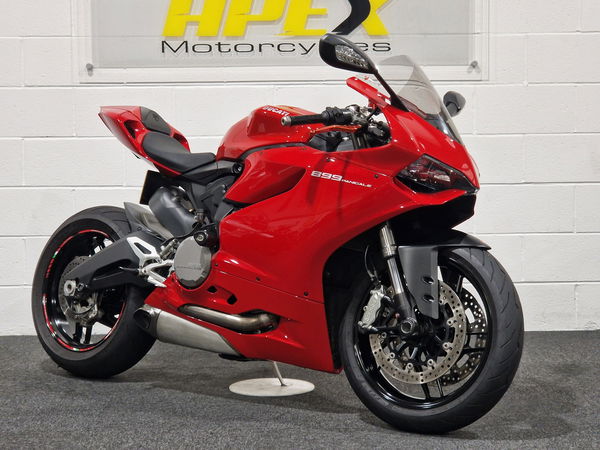Buying used: 2014 Ducati 899 Panigale
First of our new buying guides from the legend Chris Moss

Pics: Mark Manning

WHENEVER a new Ducati superbike arrives, it’s guaranteed to grab huge headlines, and rightly so; they’re usually something special. But more often than not there’s a smaller sibling waiting in the wings. When the ‘lesser’ version makes it to the showrooms it usually gets a fair dollop of justifiable praise too.
Many of the little ‘uns have actually been more realistic propositions. They cost less to buy and run, and are usually a fair bit more manageable. All in all, they can be much easier to live with.
There’ve been plenty of examples over the years. The 916 might well have stunned the biking world back in 1994, but the 748 looked just as gorgeous, rode fantastically and also won loads of races. Like its bigger brother it also came in higher spec R, S and SPS versions.
The mirroring continued when the 749 understudy came along to join the controversially-styled 999 in Duke dealers in 2002. Both models also came with R and S options. The theme kept going with the arrival of 1098 in 2006, though it took another year for the smaller 848 to appear. The 848 remained in the range for six seasons, and during that time was offered in different guides including the Dark and Evo models.
Fast forward to 2012 and the new generation, ground-breaking 1199 Panigale superbike became the Ducati superbike to have. Then late in 2013, upholding the long-held tradition, the men at Bologna unveiled the only-slightly-less-desirable Panigale for the masses, the 899. This, the bike we’re looking at here, is clothed in the same beautiful bodywork, with the same clever monocoque chassis. The smaller ‘Superquadro’ V-twin produces 148bhp and is equipped with electronic aids including traction control, ABS, engine braking control and a quick-shifter.It was replaced by the slightly larger engined, Euro-4 compliant 959 Panigale in January 2016.
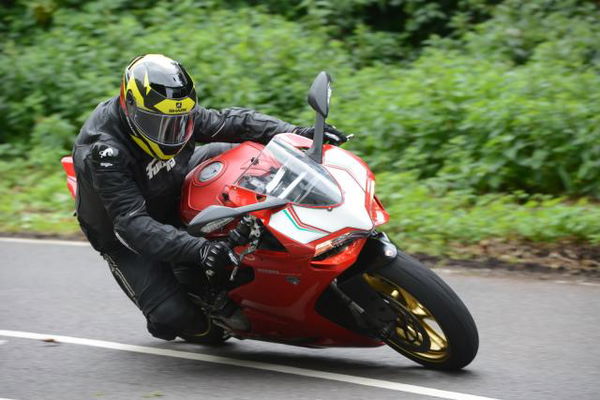
RIDING
Most Ducati sportsbikes require some level of sacrifice, with all the numerous pleasures gained from riding a Bologna-built V-twin usually coming at the expense of some level of physical discomfort. To be fair it’s a situation that’s steadily improved over recent years, but if you have one of the speedier red Italian creations, then thinking of heading off on a European tour is an unlikely early thought. When you ride an 899 Panigale though, ideas of such extended mileage are in fact one of the first things you consider. It’s a remarkable situation. Astride a gorgeously pretty red sportsbike with one of the most iconic names adorning its tank, and you feel comfortable enough to ride off into the distance. Whatever next?
It’s a scenario created deliberately. The Italians are fully aware there are plenty of fans of their racier models, but they also know those guys aren’t as young or flexible as they once were. They’d be financially foolish not to react to that state of affairs, and in late 2013 they were wise enough to introduce the 899 Panigale.
Ducati may well have already tested the water with the bikes the 899 was derived from, the earlier 1199 and 1299 Panigales. But though they’d each been accepted from an ergonomic point of view, the huge power of both bikes was considered too much for some. Their £15,000 and £16,700 price tags were also viewed discouragingly. The 899 solved both problems, with 148bhp and £12,500 being easier figures to swallow. This was a lesser Panigale offering more.
As I said, you’re made aware of the bike’s greater level of acceptance from the moment you plonk yourself in the seat. The reach to the bars and pegs has a ‘that’s more like it’ feel, with the seat itself actually giving your bum a fairly plush resting place. Head off in this business-class style and it’s obvious it’s not just the lovely riding position that makes the 899 feel so hospitable. There’s a nice action from the suspension too. Let’s face it, British roads have probably never been in a worse state, but running over all but the very worst sections is actually quite a civilised experience with springs and damping rates providing the bike with an unlikely level of compliance to the road surface.
The smoothness doesn’t come at the price of reduced control though, and the job of covering ground quickly is still something this Panigale is more than capable of. There’s also a reassuring feel from the chassis with an excellent level of composure to boost confidence at all times. Combined with the Ducati’s lightness and sharp steering, the 899 follows and sticks to your chosen course impressively accurately. And should you need to change your mind and plot a new line, the Duke’s obedience can always be relied on.
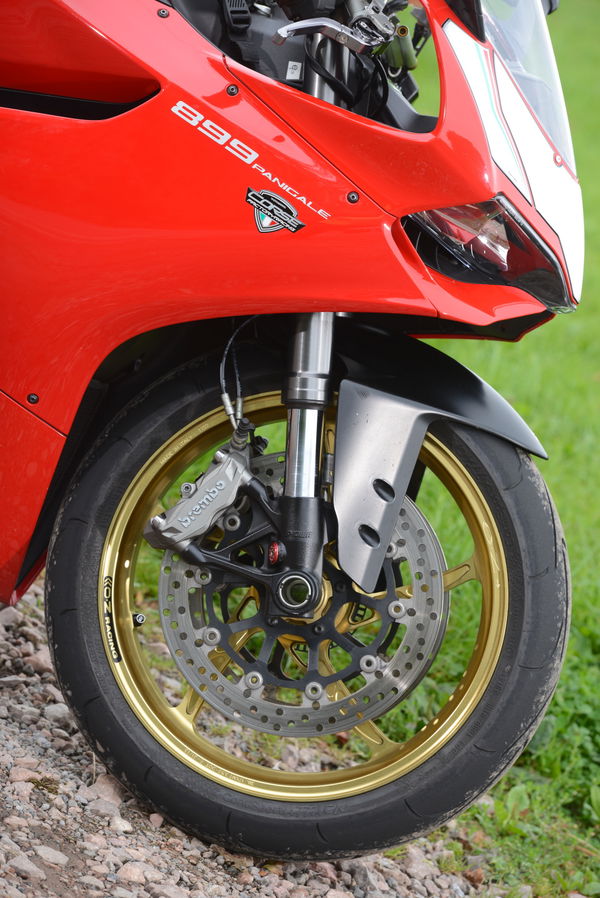
Any requirement to reduce pace is something the 899 can cope with very well too, its brakes doing a sterling, fuss-free job of retardation. It has to be said this particular bike was fitted with some Bendix aftermarket pads, which give the stoppers some strikingly powerful yet progressive feel. It was never a worry to charge into corners hard, asking them to scrub off lots of speed and then take you up to the apex of the corner with some slight pressure still applied. The stiff feel from the chassis, big piston forks, and grippy front tyre clearly helps with all this control. If that overall balance wasn’t in place there’s no way I’d have felt so confident. The faith to push on is really very encouraging and makes the rate of progress seem quite special. I’m not saying it’s as good as it gets, but it’s in that ballpark and inspires lots of further corner hunting. I never triggered the ABS once, but I definitely felt all the more comfortable having it in place.
The Panigale’s engine is also worthy of much praise, though the compliments are of a different nature to what you might expect from a Ducati V-Twin. This is obviously a sportier engine to those of old, and achieving its peak power figure of 148 bhp has come at the price of a little less enthusiasm at lower rpm. You’re never in doubt you’re aboard a V-Twin though. There’s always a typical level of keenness and sharp response to the throttle at lower rpm, but it’s a softer surge than you get with older Ducati engines of this capacity. The strongest amount of drive certainly comes at higher revs, with a very rewarding rush on offer from 6000rpm all the way up to the 10,700rpm power limit. That description might make the Panigale sound a little peaky and rev dependent, but don’t worry it isn’t. It’s more a case of it being both useful and exciting, which is not a bad combination at all.
I also like the fact you can trickle along quite happily in towns without any of the usual snatch and lumpy feel so typical of bigger V-Twins, which goes nicely with the overall well-mannered feel the motor has when you’re not in a hurry. To have that as well as having the excitement generated from holding onto gears a big longer and then feeling the impressively strong pull from the midrange upwards is a real bonus. There’s no worrying steps of increase between the two either, just a lovely linear build up of power and speed as the engine speed rises. It’s lovely. There are three different power modes available to suit your needs, which also alter the ABS and traction control settings. With a beautiful exhaust note pleasing the ears, it’s hard not to be a real fan of the big V-twin.
The 899 really is a complete sporting package. It’s not a sports tourer as such and clearly should be identified as a more focused sportsbike from its looks alone. But the real beauty of this bike is that it’s not actually that focused at all. It may have lots of strong performance, but there’s little price to pay for it. It’s comfy, not too powerful, and doesn’t have a chassis that’s too sharp or frisky. OK any idea of two-up travelling over any significant distance should be scotched straight away, as life for the pillion hasn’t been considered as carefully. Bar that though, we’ve got a Ducati that ticks a lot of real world boxes as well as all the usual ones we all love the brand for. It’s quite a bike.
NEXT - THE USEFUL STUFF! WHAT GOES WRONG, EXPERT'S VIEW, VALUES
Buying used: 2014 Ducati Panigale 899 - page two
PICS: MARK MANNING

EXPERT’S VIEW
Iain Rhodes of RPM bikes (www.rpmbikes.co.uk, 01604 583350), an independent with lots of history with Ducatis, gave us his thoughts.
“The 899 Panigale is a real world Ducati. It’s been made for the masses to ride and enjoy more easily, and is a lot less costly to run. It’s not likely to give you any shocking bills. It shouldn’t be confused with older Dukes. Ducati’s mechanicals are getting stronger by the year and the 899 Panigale is a good used buy in that it’s very reliable, and has no common faults. Owners are usually older and more affluent and don’t skimp on maintaining their bikes at the right places. They’re generally used for more special occasions, and not for things like commuting. Most riders only clock up around 3,000 miles or even less in a year. As long as the bike you’re interested is in good condition and has the all important full service history, then you can look forward to a happy life together."

“Some bikes haven’t been cleaned as often as possible, and fasteners on the lower part of the bike can corrode quite readily. If the rest has been looked after, then this shouldn’t put you off. Home maintenance can be a bit fiddly as the fairing takes a while to get off. Oil and filter changes aren’t too bad – though the filter needs to be extracted rather than just simply removed by hand. Front cylinder access isn’t too easy, though with enough time and patience, you can check the plugs and valves. Clearances are usually OK for 20,000 miles or more, though you need a special tool to change the shims. A bit of smoke from the exhaust on start up isn’t unusual and they can burn a bit of oil if they’re used harder."

“They don’t always crash too well, as there are lots of sub-assemblies and bits that sit proud of the rest of the bike that get damaged easily. Spares are a bit more costly, but you can get anything within a few working days. Consumables are always in stock. Lots of owners fit tasteful aftermarket parts like cans, footrests and carbon components. I’ve never seen any bikes fitted with cheap tat. End cans need to have a map downloaded for them to work best.
“Some see them as a poorer man’s 1199 or 1299, I see them as more realistic, usable. and comfortable options.”
WHAT ABOUT THESE?
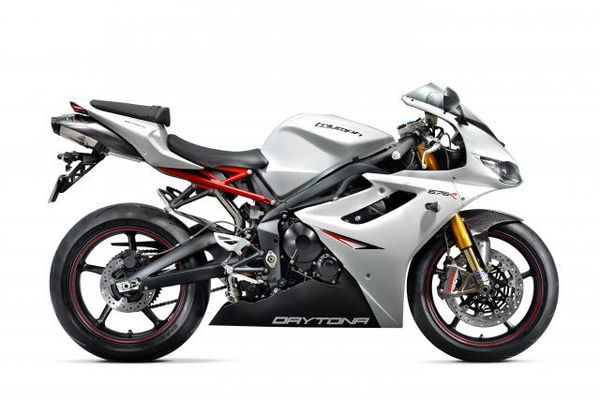
Triumph 675R, 2013-current, 675cc, in-line triple, 126bhp, 167kg
Triumph’s fastest sportsbike boasts plenty of high spec components, tons of character, and a British badge. Its in-line tripe engine has power, flexibility and an absolutely gorgeous soundtrack. Not being Euro-4 compliant means when stocks sell out, it’ll be no more. Pity. More focused than the Panigale but with similar appeal.

MV 800F3, 2013-current, 798cc, in-line triple, 148bhp, 173kg
Exotic, well-equipped MV has very strong performance and plenty of head-turning potential. The stylish Italian steed has a usable, revvy engine with an excellent chassis able to cope all that’s thrown at it. Fun and easy to ride, the F3 makes is a rare sight on UK roads. Uncertain dealer back up is a significant drawback.
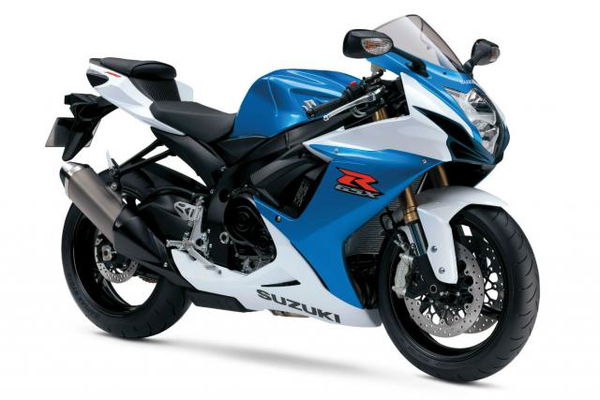
Suzuki GSX-R750, 2011-current, 749cc in-line four, 148bhp, 170kg
Latest three-quarter litre GSX-R may be the last if the poor appetite for sportsbikes continues. Superbly balanced, the Gixxer is very usable providing plenty of pace with less intimidation – road or track. More comfortable than you’d think too. Doesn’t have the same sheer wow-factor of the Duke, but it’s a cheaper option.

KTM RC8 R, 2011-2015, 1195cc, 75°V-twin, 175bhp, 184kg
Not as successful as KTM had hoped for, in either standard or R trim, the big V-twin still has plenty going for it. Strong, grunty power gives plenty of speed readily, with a hi-spec chassis keeping it all in check nicely. Unique style, roomy adjustable riding position and rarity value may well make it a collector's item in future?

WHAT GOES WRONG?
The 899 Panigale is a good used buy in that it has a very good reputation for reliability and is usually owned by older, more conscientious types who look after their bikes well. Service intervals are realistic, and as you can look after most smaller service items yourself running costs can be quite reasonable. It should be viewed as a more modern and robust Ducati – which hasn’t always been the case with many previous models. Any thoughts of, ‘It’s a Ducati, it’s bound to breakdown’, really should be dismissed.
You’ll probably need to travel to see one as they’re not that readily available. As long as a full service history (done by an approved outlet) can be shown, and the bike doesn’t show any evidence or real neglect, then you should be OK. A bit of light corrosion isn’t unheard of with fasteners looking scruffy quite readily if the bike’s used in poor conditions or not cleaned often enough. This shouldn’t be worried about too much, but it’s worth having a more thorough look under the plastic to see if it’s any worse under there. It should be noted most 899s are kept in tip-top condition, so you don’t have to buy anything under par. It’s a buyer’s market. Annual mileage is around 3000 miles or less, so a fair number have yet to have a full 15,000-mile service. As the price of this is not really any more pricey than most machines, this shouldn’t put you off. Factor in the cost if it’s imminent, though bear in mind valve clearances usually stay in tolerance for up to 20,000 miles or possibly more. Engines should run quietly, though a small amount of smoke on start up isn’t unusual.
Many bikes will have had tasteful extras fitted which normally make them even more desirable, though it’s always handy to get the original parts. If stuff looks like it’s been replaced to sort crash damage then look round the bike even more carefully. Lots of components can get damaged even in a slow speed fall. Parts aren’t always cheap.
Any bike of very low mileage needs checking carefully. Longer periods of storage requires special care. Conditions ideally need to be warm and dry to fend off any corrosion and the battery needs to be kept fully charged. Engine oil needs to be changed every year, regardless of mileage. Motors shouldn’t be started without being run up to full temperature otherwise condensation will harm the internals.
VALUES
£8,000-10,500
* Prices are for early models sold privately in average condition to newer, well cared for examples available at dealers.
KEY POINTS
SERVICE HISTORY
Proof of a full service history is important. The 899 Panigale isn’t as fragile as older Dukes, and far more robust and tolerant of servicing being done late. Even so, a service history is the best guide to the attitude of the owner and sort of attention the bike’s had.
ENGINE
Not as lazy and relaxed as earlier bigger V-twins, thanks to its short stroke design, the Panigale motor needs to be revved more to give its best. In saying that, it’s still pretty flexible and pulls keenly from lower rpm. It’s better in town where it’s much less snatchy at lower speeds. It’s very reliable if it’s looked after.
SUSPENSION
Up front the forks work well with good compliance and control. The performance of the rear shock isn’t quite as good. Fitting an 1199 or 1299 Panigale unit improves matters, though a good quality aftermarket shock offers the best solution.
SPARES AVAILABILITY
Spares are readily available, even if they do cost a bit more. Expect anything to arrive within 2-3 working days. More regularly used items are nearly always in stock at dealers.
SERVICING
Servicing intervals are longer and cost less than those of earlier belt driven V-twins. And though the 899 is more tolerant of extending some service items a little, it can affect the way the bike’s value is perceived. Changing the engine oil and filter on time and using good quality stuff is essential. Ducati recommend using Shell Advance Ultra 4T. 899s can burn oil, and there’s no inspection window in the fairing to check the level. Do it before every ride.
HOME MAINTENANCE
Oil and filter changes are quite straightforward. Air filter inspection is also pretty easy. However, top end jobs like plug and valve checks are much more involving. They can be done, but you must be very patient. Valve clearances rarely go out of tolerance before 15,000 miles, but need a special tool to allow shim changes.
BRAKING PERFORMANCE
Standard brake pads are fine for all road work. However if you want to do trackdays, then fitting a more appropriate compound is essential to cope with the higher demands
TOURING
So comfortable is the riding position and seat, the Panigale can easily be entertained for longer distance runs. With a tank bag, seat and back packs, a two week tour of Europe is easily possible. However, don’t consider taking a pillion too far as their accommodation is nowhere near a luxurious.
STORAGE
If the Ducati isn’t being used it needs to be stored with care to avoid problems. Ideally the bike needs to be parked in a warm dry place and unless the engine gets up to full temperature via a ride of at least 10 miles, it shouldn’t be started. Even if the bike’s not ridden, oil should still be changed as advised. Batteries should be kept fully charged.
DEALER SERVICING; intervals / costs
Every 7,500 miles/12 months = £200-250. At 15,000 miles = £350-450
* Costs will vary depending on labour rates and condition of your bike and parts
required
SPECIFICATIONS
Price:£8,000-10,500
Engine:898cc, liquid-cooled, dohc, desmodromic 8v, 90°V-twin
Power:148bhp @ 10,750rpm
Torque:73lb/ft @ 8000rpm
Dry weight:169kg
Frame: aluminium monocoque
Suspension:43mm inverted telescopic forks and rising rate monoshock, both fully adjustable
Brakes:Twin 320mm discs, four-piston front calipers; 245mm disc, twin-piston rear caliper
Tyres:120/70-17 front, 180/60-17 rear
Seat height:830mm
Wheelbase:1430mm
Fuel capacity: 17 litres

